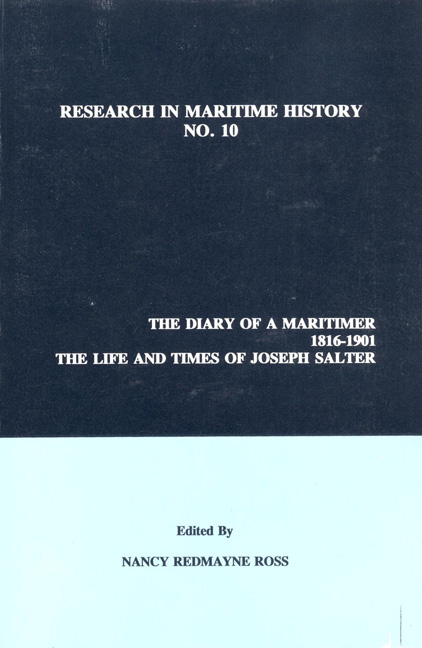Book contents
- Frontmatter
- Contents
- Foreword
- Introduction
- List of Illustrations
- Chapter 1
- Chapter 2
- Chapter 3
- Chapter 4
- Chapter 5
- Chapter 6
- Chapter 7
- Chapter 8
- Chapter 9
- Chapter 10
- Chapter 11
- Chapter 12
- Chapter 13
- Chapter 14
- Chapter 15
- Chapter 16
- Appendix 1 Vessels Owned by G. & J. Salter, 1852-1857
- Appendix 2 Patent Application, 1867
- Appendix 3 Genealogy
- Appendix 4 A Brief History of the Shipyard of G. & J. Salter
Chapter 10
- Frontmatter
- Contents
- Foreword
- Introduction
- List of Illustrations
- Chapter 1
- Chapter 2
- Chapter 3
- Chapter 4
- Chapter 5
- Chapter 6
- Chapter 7
- Chapter 8
- Chapter 9
- Chapter 10
- Chapter 11
- Chapter 12
- Chapter 13
- Chapter 14
- Chapter 15
- Chapter 16
- Appendix 1 Vessels Owned by G. & J. Salter, 1852-1857
- Appendix 2 Patent Application, 1867
- Appendix 3 Genealogy
- Appendix 4 A Brief History of the Shipyard of G. & J. Salter
Summary
[From the diary:]
On 6th February, 1856, Clifford was born. Until very recently this fine fellow was called by his mother her “treasure.” He now says he is “Bah's Boy” meaning me. He is very backward in learning to talk — over 2 1/2 years old. He had a severe burn by falling on a hot air register, when about 1 year old. Afterwards we came near losing him by fever and inflammation of the chest. He is not named for anyone. One Sunday, Maggie and I, with our faced to the organ (on which she performs at the Wesleyan Chapel) — at prayer time the tune “Clifford” in the Boston Academy was before us. I pointed my pencil to it, M. nodded her head, and ever after he went by (and was baptized by, of course) that name. He can sing “My Mary Ann,” “Lift up a Standard” etc. very well, barring the words.
In 1856 the Lady Clarendon (the largest one of the fleet) and the Melbourne were built. Re-elected Mayor again without opposition. August 16 — Left Halifax for Liverpool in the Arabia Capt. Stone.
25th — 7 A.M. off Holyhead. After an ineffectual effort to change our account or to sell the Lady Clarendon. I closed a contract for the hull of a ship of 900 tons - to class 8 years - with James Ewing, Esq.
Quite an interesting incident transpired just after closing the contract for this ship. Mr. Ewing invited me to dine with him, and on my arrival at his house he, after receiving, left me alone in the drawing room a few moments. After he left, my eyes wandered around the walls for the pictures as they always do, when they were arrested by the spars of a ship (the room abounded in marine paintings, chiefly of his own ships) exactly similar to those I gave bills of (the placing of the masts, rake - length etc. were peculiar, and my own) and I immediately walked over to see the name, and to my surprise saw that it was the Recruit with the “Girl of the Regiment“ figure-head, that I had put on her with so much pride of my taste, a few years before.
Information
- Type
- Chapter
- Information
- The Diary of a Maritimer, 1816–1901The Life and Times of Joseph Salter, pp. 147 - 154Publisher: Liverpool University PressPrint publication year: 1996
